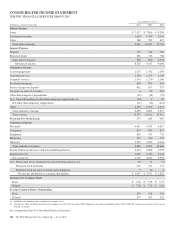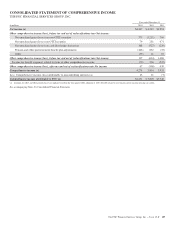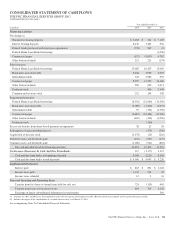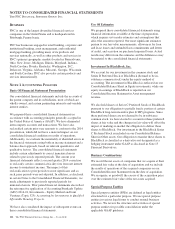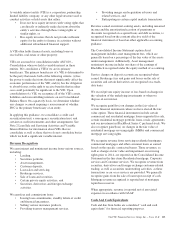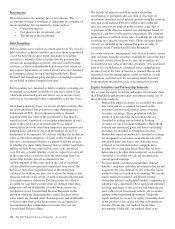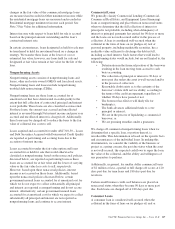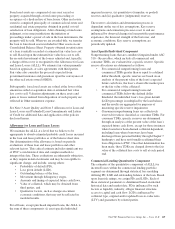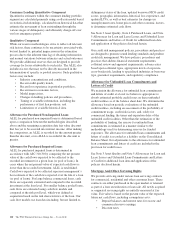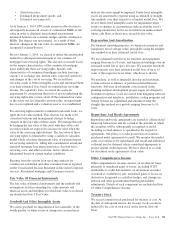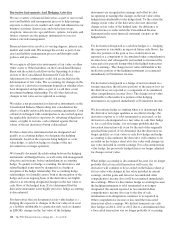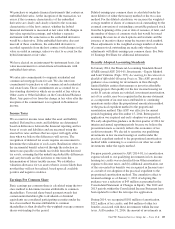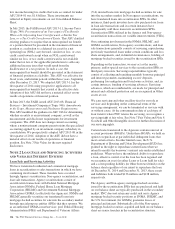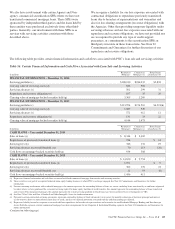PNC Bank 2014 Annual Report Download - page 134
Download and view the complete annual report
Please find page 134 of the 2014 PNC Bank annual report below. You can navigate through the pages in the report by either clicking on the pages listed below, or by using the keyword search tool below to find specific information within the annual report.
interest income over the remaining life of the loan (or pool of
loans) using the constant effective yield method. The
accretable yield is calculated based upon the difference
between the undiscounted expected future cash flows of the
loans and the recorded investment in the loans. Subsequent
decreases in expected cash flows that are attributable, at least
in part, to credit quality are recognized as impairments
through a charge to the provision for credit losses resulting in
an increase in the ALLL. Subsequent increases in expected
cash flows are recognized as a provision recapture of
previously recorded ALLL or prospectively through an
adjustment of the loan’s or pool’s yield over its remaining life.
Leases
We provide financing for various types of equipment,
including aircraft, energy and power systems, and vehicles
through a variety of lease arrangements. Direct financing
leases are carried at the aggregate of lease payments plus
estimated residual value of the leased property, less unearned
income. Leveraged leases, a form of financing lease, are
carried net of nonrecourse debt. We recognize income over
the term of the lease using the constant effective yield method.
Lease residual values are reviewed for impairment at least
annually. Gains or losses on the sale of leased assets are
included in Other noninterest income while valuation
adjustments on lease residuals are included in Other
noninterest expense.
Loan Sales, Loan Securitizations And Retained
Interests
We recognize the sale of loans or other financial assets when
the transferred assets are legally isolated from our creditors
and the appropriate accounting criteria are met. We have sold
mortgage, credit card and other loans through securitization
transactions. In a securitization, financial assets are transferred
into trusts or to SPEs in transactions to effectively legally
isolate the assets from PNC.
ASC 860 – Transfers and Servicing requires a true sale legal
analysis to address several relevant factors, such as the nature
and level of recourse to the transferor, and the amount and
nature of retained interests in the loans sold to support whether
the transferred loans would be legally isolated from the
transferor’s assets in the case of bankruptcy. Once the legal
isolation test has been met, other factors concerning the nature
and extent of the transferor’s control and the rights of the
transferee over the transferred assets are taken into account in
order to determine whether derecognition of assets is warranted.
In a securitization, the trust or SPE issues beneficial interests in
the form of senior and subordinated securities backed or
collateralized by the assets sold to the trust. The senior classes
of the asset-backed securities typically receive investment grade
credit ratings at the time of issuance. These ratings are generally
achieved through the creation of lower-rated subordinated
classes of asset-backed securities, as well as subordinated or
residual interests. In certain cases, we may retain a portion or all
of the securities issued, interest-only strips, one or more
subordinated tranches, servicing rights and, in some cases, cash
reserve accounts. Securitized loans are removed from the
balance sheet and a net gain or loss is recognized in Noninterest
income at the time of initial sale. Gains or losses recognized on
the sale of the loans depend on the fair value of the loans sold
and the retained interests at the date of sale. We generally
estimate the fair value of the retained interests based on the
present value of future expected cash flows using assumptions
as to discount rates, interest rates, prepayment speeds, credit
losses and servicing costs, if applicable.
With the exception of loan sales to certain U.S. government-
chartered entities, our loan sales and securitizations are
generally structured without recourse to us except for
representations and warranties and with no restrictions on the
retained interests. We originate, sell and service commercial
mortgage loans under the Federal National Mortgage
Association (FNMA) Delegated Underwriting and Servicing
(DUS) program. Under the provisions of the DUS program,
we participate in a loss-sharing arrangement with FNMA. We
participated in a similar program with the Federal Home Loan
Mortgage Corporation (FHLMC). When we are obligated for
loss-sharing or recourse, our policy is to record such liabilities
initially at fair value and subsequently reserve for estimated
losses in accordance with guidance contained in applicable
GAAP. Refer to Note 22 Commitments and Guarantees for
more information about our obligations related to sales of
loans under these programs.
Loans Held For Sale
We designate loans as held for sale when we have the intent to
sell them. We transfer loans to the Loans held for sale
category at the lower of cost or estimated fair value less cost
to sell. At the time of transfer, write-downs on the loans are
recorded as charge-offs. We establish a new cost basis upon
transfer. Any subsequent lower-of-cost-or-market adjustment
is determined on an individual loan basis and is recognized as
a valuation allowance with any charges included in Other
noninterest income. Sale proceeds that are in excess of the
new cost basis upon transfer and are received within 90 days
of classifying the loan as held for sale are recorded as a
recovery to the ALLL up to the amount previously charged
off. Any remaining proceeds that exist after recovery are
recorded as a gain on sale included in Other noninterest
income. Sale proceeds that are less than the new cost basis
upon transfer and are received within 90 days of classifying
the loan as held for sale are recorded as a charge off to the
ALLL. Any proceeds received after 90 days of classifying the
loan as held for sale are recorded as a gain or loss on sale and
included in Other noninterest income.
We have elected to account for certain commercial and
residential mortgage loans held for sale at fair value. The
116 The PNC Financial Services Group, Inc. – Form 10-K


